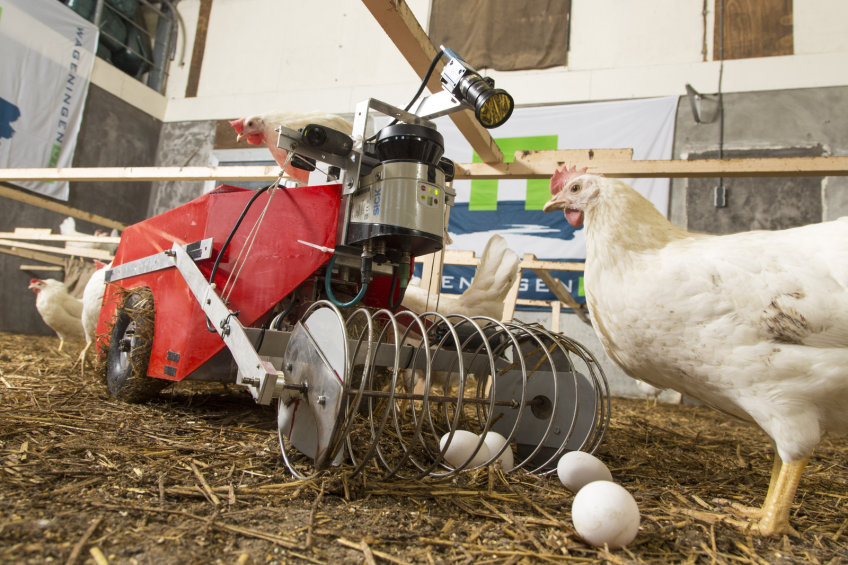Is robotic egg collection the future?

Chickens lay most of their eggs in their nests, but some end up in the hay. Egg collection is therefore both necessary and time-consuming. In response to this need, Wageningen researchers in the Netherlands have developed an autonomous robot that can move through the poultry house freely.
The aim of the robot, named the PoultryBot, is to identify and collect missing eggs, thereby saving poultry farmers thousands of euros per year. It is also equipped with a device that can measure the poultry house climate or look after sick animals. World Poultry spoke with Bastiaan Vroegindeweij, the PhD candidate involved in the project to learn more.
World Poultry: How did the idea originate to develop a robot for the collection of eggs?
Bastiaan Vroegindeweij: Current measures to deal with issues such as misplaced eggs all rely on manual labour and control. It is a physically and time demanding job, so there is a need to ease and improve this collection. During the Field Robot Event of 2007, the idea of collecting floor eggs (outer-nest eggs on the litter) with help of a robot emerged. I have since been involved in this project, and co-ordinated most of the development work. This includes searching for appropriate methods and technologies, testing them for use in poultry house conditions and integrating them into the proof-of-concept.
How big is the problem with missing eggs?
The problem of floor eggs is dependent on the housing system used. When using cage housing, it is not an issue as a result of system design. However, when switching to/using loose housing systems for egg-laying poultry (laying hens, breeders, ducks, quails, etc), this problem will immediately occur, as result of mismatch between the offered laying nests and the expectations/desires of the hens. Thus, all poultry houses with loose-housed hens (both in NL, EU and worldwide) suffer from the floor egg problem. In properly managed flocks of laying hens, the amount of floor eggs can be reduced to less than 0.5% of daily production. In an average-sized flock under Dutch conditions, of about 30.00 animals, this still requires about 1 hour of labour/day for collecting these eggs. However, in other cases (with laying hens, but also with specific types of breeder flocks), it can reach levels of 5-10% of daily production, which then also gives an increased workload. Furthermore, one of the major contributions to a low floor egg percentage is their frequent collection.
For what kind of poultry farms would this robot be an advantage?
Taking into account this knowledge, the current development makes immediate sense for North-West Europe, where as a result of the EU-wide ban on traditional cages, a large part of the laying hens are housed in loose housing systems. However, as we expect (and see) that this way of housing of poultry is spreading, we see wider opportunities. For example, furnished cages, which is the major alternative for the traditional cage in southern Europe, might be banned in future as well. Also, we see more and more of the alternative (barn-type) housing spreading to other parts of the world, like the US and Australia, but also China and Brazil. In some places cheap labour might be present to perform the job of floor egg collection, but this might not always be the case. Furthermore, the quality of this labour might also be a reason to opt for automation, if available.
| Bastiaan Vroegindeweij, PhD candidate, Wageningen UR: “PoultryBot will become an important asset to poultry farmers. It will take over hard manual labour and act as an extra set of eyes and ears with a continuous presence among the animals.” |
In addition, if you have such a floor egg collection device operating inside your poultry house, it is relatively easy to equip it with more sensors, to act as additional eyes and ears for the farmer, to provide him with continuous and local information about the condition (both health and welfare) of his flock. In this regard, the current development is not only beneficial for layers, but also broiler farmers have some clear benefits from what we are developing.
How exactly does the robot find the eggs and collect them without causing damage?
We use a path planner to search the house, in such a way that the change of finding floor eggs is maximised. This path planner provides waypoints to the robot, which then drives from waypoint to waypoint. At the same time, a special camera is used to detect the eggs. If an egg is found, its position is stored (the robot is continuously aware of its position in the house), and an action is planned to collect the egg. Using our special collection mechanism (a bended helical spring), it is sufficient to stop in front of the egg, lower the mechanism and push it over the egg. At that time, the egg will move into the device, and can be handled further by the robot.
On what kind of time-scale do you see this becoming commercial available?
What we have presented so far, is a proof-of-concept. This is sufficient to make clear that the idea and approach are valid and can work, but does not mean that we have a fully functional robot yet. The plan is to continue the development in the coming years, and we hope that in a few years’ time we have a fully functional prototype.

| The autonomous robot, currently in the proof-of-concept stage can move freely through the poultry house. |
What would it cost for a poultry producer and can you say anything on the ROI?
Given the fact that collecting these floor eggs costs about 1 hour/day/per henhouse, at an hourly wage of €25, this amounts to about €10,000 per year. If the robot has a lifetime of 5 years, a quick estimate of its costs indicate that the price might be around €50,000. This does not yet include a reward for the extra freedom it offers to the farmer, or other things it can perform.
With who have you collaborated on this project?
The work is all done within the Farm Technology Group of Wageningen University, with help of a large number of students and a few members of the staff. Partial funding for the PoultryBot project was provided by the Dutch Poultry sector, represented by Fonds Pluimveebelangen.
Join 31,000+ subscribers
Subscribe to our newsletter to stay updated about all the need-to-know content in the poultry sector, three times a week. Beheer
Beheer











 WP Admin
WP Admin  Bewerk bericht
Bewerk bericht